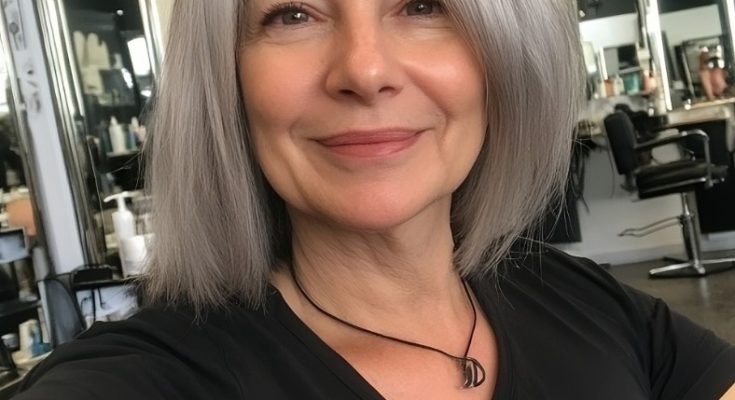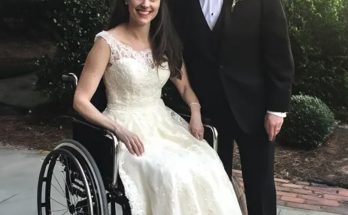It happened just the other day. My wife finally went to the salon—a trip I’d been nudging her toward, hoping she’d ditch her gray hair. But when she returned, to my surprise, the gray remained. Sure, she had a new haircut, but that “mousey” shade of gray still covered her head. I won’t lie—I felt a tinge of embarrassment. But as I took a step back, I began to understand the deeper meaning behind her choice. Now, I want to share this story with other husbands and partners who, like me, may need a gentle reminder about love, acceptance, and the beauty of aging gracefully.
Gray Hair and Society: Why Women Have Felt Pressured to Hide the Gray

In a world that glorifies youth, women often feel an overwhelming pressure to mask any sign of aging. For many middle-aged women, gray hair becomes something to hide, rather than embrace. As the years go by, the pressure only mounts. The beauty industry has long thrived on the notion that aging is something to combat, not accept. Ads from major brands like L’Oréal and Clairol have reinforced this idea, marketing hair dye as a necessity for staying youthful.
But things are changing. In recent years, the message has shifted toward embracing one’s natural self. Movements like #GreyHairDontCare have swept across social media, encouraging women to break free from societal expectations and to celebrate their natural beauty—gray hair and all.
The Growing Movement: #GreyHairDontCare and Its Impact on Beauty Standards
If you’ve been on Instagram or TikTok lately, you’ve probably seen the hashtag #GreyHairDontCare. What started as a small movement has gained massive traction, with influencers, celebrities, and everyday women proudly showing off their silver strands. These women aren’t just embracing gray hair; they’re challenging outdated beauty standards that equate gray hair with aging poorly.
Influential figures like Andie MacDowell, Helen Mirren, and Jodie Foster have shown up on the red carpet flaunting their gray hair, proving that age is just a number. Platforms like Instagram are filled with profiles such as @agingwith_style_and_grays, showcasing women who defy traditional beauty norms. The hashtag #GreyHairDontCare alone has amassed millions of views, highlighting how quickly this movement has taken root.
Why Women Are Choosing to Go Gray: The Shift in Perspective After COVID-19
Interestingly, the COVID-19 pandemic played a significant role in shifting attitudes toward gray hair. During lockdowns, salons closed, and many women found themselves unable to keep up with regular dye jobs. Instead of attempting risky DIY dye jobs at home, some decided to let their gray hair grow out naturally. For many, this experience was a revelation. Women of all ages began to see their gray hair as a part of their identity, a badge of resilience during challenging times.
The pandemic also gave people time to reconsider what really matters. Beauty routines once essential became less important in the grand scheme of things. As a result, more women began to appreciate their natural beauty, seeing their gray hair as something beautiful and unique, rather than something to hide.
Famous Figures Leading the Gray Hair Revolution
It’s no coincidence that so many high-profile women have started embracing their gray hair. From actresses to royals, the gray hair trend has captured the attention of some of the most influential women around the world.
Consider Princess Caroline of Monaco, who debuted a sleek silver bob in 2021, or Queen Letizia of Spain, who allowed gray streaks to shine through her dark hair. These are women who are deeply respected and admired, and their choices make a statement. By going gray, they send a message that aging is something to be celebrated, not feared.

This acceptance among public figures encourages everyday women to take a similar approach, validating their choices and showing that beauty transcends hair color.
The History of Gray Hair Stigma: A Not-So-Distant Past
For decades, gray hair was stigmatized, and the world of celebrities was no exception. Women with gray hair were often perceived as older, less capable, and out of touch. Until recently, gray hair symbolized the opposite of youth, vibrancy, and desirability. Women who dared to embrace their gray were often met with questions and criticisms.
Nora Ephron, a celebrated author, once joked, “There’s a reason why women in their 40s, 50s, and 60s don’t look the same today… it’s because of hair dye.” She was right—historically, hair dye has been marketed as the ultimate tool for anti-aging. In the 1950s, only 7% of American women dyed their hair, but today, countless women feel obligated to hide their gray.
How the Beauty Industry Profited from Women’s Insecurities
The pressure on women to hide their gray hair didn’t happen by accident. For years, the beauty industry promoted the idea that gray hair was unattractive, using it to sell hair dye products by preying on women’s insecurities. Brands like Clairol ran campaigns portraying gray hair as a “cruel tyrant” that would ruin a woman’s life if left untreated.

As the “Gray Hair, Don’t Care” movement gains traction, the beauty industry faces a unique challenge. Will more women embracing gray hair disrupt the lucrative hair dye market? Today, the global hair color industry is valued at over $21 billion, but with more women choosing to go gray, we may see a shift in consumer behavior. Some companies, like Dove, have already begun to adapt, launching campaigns that celebrate aging naturally, proving that change is possible.
The New Normal: Gray Hair as a Symbol of Confidence and Strength
The shift toward embracing gray hair represents more than just a change in beauty standards; it’s a change in attitude. Women are reclaiming their identities, choosing to be their authentic selves rather than conform to unrealistic expectations. Gray hair has become a symbol of resilience, experience, and self-assuredness.
A woman with gray hair today may be dynamic, professional, and stylish—challenging the stereotypes that were once associated with aging. It’s a powerful statement of confidence, one that says she is unapologetically herself, regardless of society’s outdated views.

Conclusion: Learning to Appreciate the Beauty of Gray
So, when my wife returned from the salon with her gray hair intact, I learned a valuable lesson. She wasn’t just keeping her natural color; she was embracing who she is—gray hair and all. This choice represents a deeper understanding of beauty, one that isn’t about hiding or covering up but celebrating the person she has become.
Embracing gray hair may not be for everyone, but for those who choose it, it can be a journey of empowerment and self-discovery. And for the rest of us, it’s a reminder to love and appreciate the people in our lives for who they are, in all their natural beauty. Because in the end, love isn’t about hair color. It’s about seeing the person beyond it—and supporting them in every choice they make.



